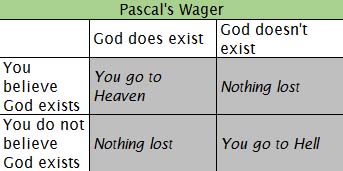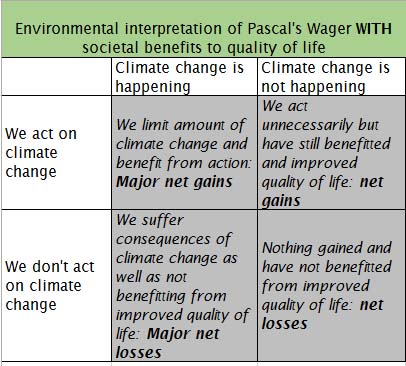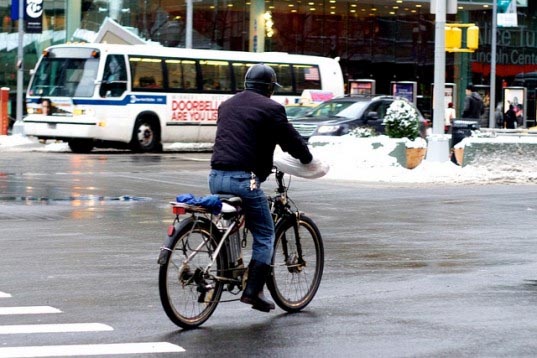The prevailing view among conservative politicians and their funders (though not so much among actual conservative voters) is that responding to climate change is either unwarranted because it doesn’t exist or unaffordable and undesirable because of the costs and the supposed sacrifices entailed.
Both of those positions, of course, are not valid. I don’t need to go into the falsehoods and disinformation in climate change deniers’ arguments. That’s been dealt with exceedingly well by many others. And in terms of the deniers’ second path of objection – cost and sacrifice – the rebuttal to that is the very basis of EcoOptimism: the things we need to do in response to climate change are desirable in and of themselves.
This latter point brings to mind a famous philosophical argument for believing in God whether or not God actually exists. It’s a type of gaming argument, known as Pascal’s Wager, and it goes like this:
- If you believe in God and God does exist, you will be rewarded with eternal life in heaven: thus an infinite gain.
- If you do not believe in God and God does exist, you will be condemned to remain in hell forever: thus an infinite loss.
- If you believe in God and God does not exist, you will not be rewarded: thus a finite loss.
- If you do not believe in God and God does not exist, you will not be rewarded, but you have lived your own life: thus a finite gain.
There’s no way I want to get into a discussion of the existence of God, but the great thing about Pascal’s Wager is that it pretty much says you might as well believe in God since three of the four conditions say it’s in your best interest.
As others have observed [some of the top ones in a quick Google search: 1, 2, 3], we can make a similar argument regarding climate change. (Note I’m using the prevailing term, but I prefer to refer to climate disruption or, better yet, climate chaos.)
But the EcoOptimism take on this is slightly different. The “conventional” environmental version of the wager is that we could lose out in some of the scenarios. However that argument omits the non-environmental benefits of responding to climate change. The argument here comes down to the observation that, as I wrote above, the things we need to do in response to climate change are desirable in and of themselves.
Another important point about this variation on Pascal’s Wager: the original wager merely referred to believing in God; not on doing anything to follow through on the belief. My climate change variation requires action. It’s not sufficient to merely phrase the argument in terms of believing in climate change; the validity of the argument is also predicated on acting on climate change:
- If we believe in and act on climate change and climate change does exist, we will be rewarded with both sustainability and thriving lives and civilization: thus an infinite gain.
- If we do not believe in and do not act on climate change and climate change does exist, we will be condemned to either greatly diminished lifestyles or human extinction: thus an infinite loss.
- If we believe in and act on climate change and climate change does not exist, we will still be rewarded with thriving civilization: thus an infinite gain.
- If we do not believe in and do not act on climate change and climate change does not exist, we will not be rewarded, but we will not have gained anything either: thus a finite loss.
Basically, the climate change “wager” says we’ve got everything to gain and nothing to lose.







